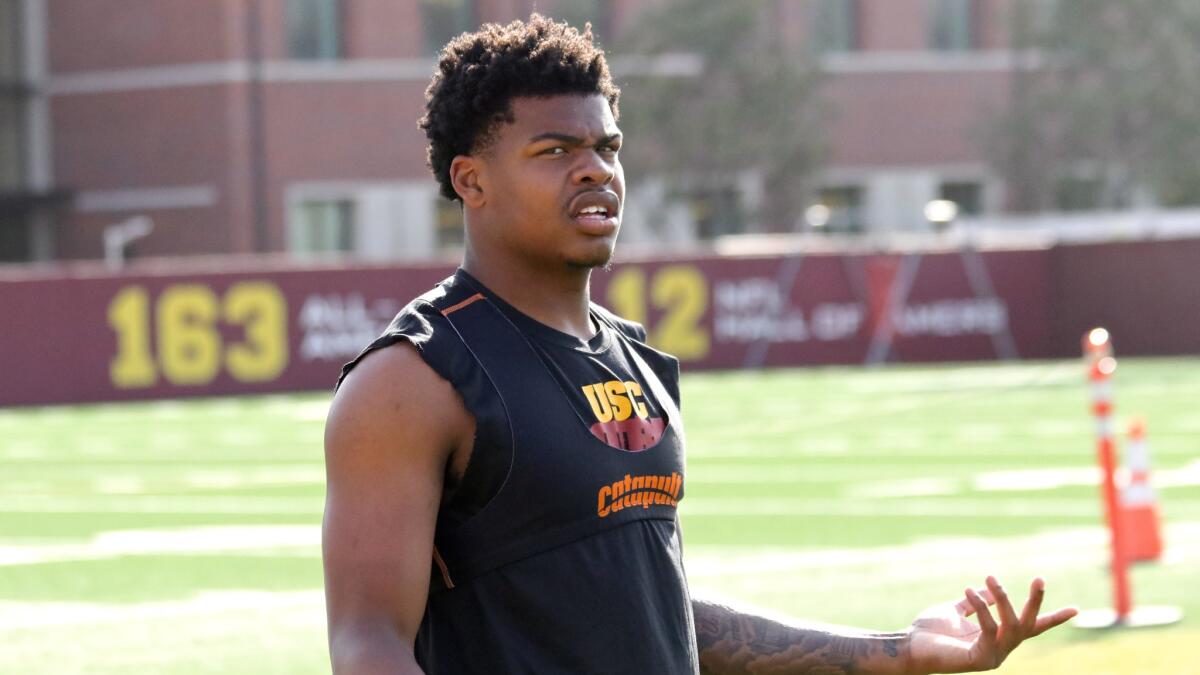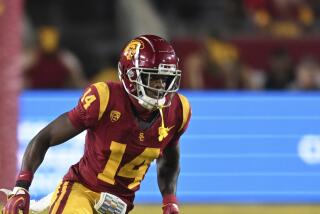USC players don pads, helmets, GPS technology to sharpen their game

- Share via
Danny van Dijk couldn’t afford to waste anyone’s time. USC was preparing to face Nebraska in the Holiday Bowl in 2014 and he was just an unpaid intern on the strength and conditioning staff.
But 15 wearable GPS devices, given to the program to test, were collecting dust. Van Dijk was sure he could make use of them.
Ivan Lewis, USC’s head strength and conditioning coach, carried a message for him to then-coach Steve Sarkisian: “Look, I have a guy downstairs who really understands this stuff,” Lewis said. “I think he could really help us.”
Word of Van Dijk, a curious Australian who’d shown up one day looking for work, trickled up the USC food chain. Sarkisian was all in. Mark Jackson, a senior associate athletic director at the time, was intrigued. Pat Haden, then the athletic director, purchased 60 devices and gave Van Dijk a full-time job.
With that, the Trojans started tracking their players with data-collecting devices that could be worn during practices and games. And as USC stares down the rest of its punishing schedule after a 52-6 loss to Alabama, the technology is helping the Trojans track the progress of recovering players and the workload of their healthy ones.
“The more continuity that we have with our coaches, which we have now, the more accurate we can be when analyzing data on players,” said Van Dijk, who is an assistant strength and conditioning coach. “As Coach [Clay] Helton and his staff shape practices and game prep the way they want, we are going to be able to make suggestions that are more and more worthwhile.”
Nearly a decade ago, Australian sports scientists looked at the limitations of existing technology.
A treadmill could show how far and how fast athletes ran. Hooking them up to machines in a lab could offer supplemental data. But after that, there was no way to track an athlete while they played their sport.
That led to a wearable device powered by GPS technology. The units USC uses, produced by a company called Catapult, record not only distance and speed, but also acceleration, deceleration and how movement affects an athlete’s body.
Brian Kopp, the president of Catapult’s North American division, explains the technology in simple terms: A player can cover the length of a football field by jogging, sprinting or by making small, sharp cuts every 10 yards.
If you looked at distance alone, all three of those scenarios would provide the same metric. But they are very different experiences for each individual athlete, and the data show those distinctions.
Kopp said Catapult devices are being used by 22 NFL franchises, half of the Pac-12 Conference’s football teams and more than half of the college teams in Power Five leagues.
“With college football, we think our technology allows teams to peak at the right time,” Kopp said. “It’s all about being ready for Saturday, and also the stretch of the season. You don’t want to be sore, but you don’t want to be under-prepared physically, either. There’s a fine balance there.”
When Van Dijk first started putting Catapult devices on USC football players — they are placed inside a band and situated on players’ backs underneath their pads and jersey — he repeatedly told coaches it wouldn’t prevent injuries. But he has found it helpful when bringing players back from injury.
Van Dijk looks closely at high-speed running, what he calls “game-like movements,” and Player Load, a metric developed by Catapult. Player Load combines all of an athlete’s movement into a whole number, making it easier for Van Dijk to explain data to coaches.
During practices, he sits in front of his laptop, tracking data as it is collected. He marks down the start and end time for each period of practice — positional reps, 7-on-7 scrimmages, special teams drills, and so on — so he can later see how each player’s body responds to specific workloads.
This gives USC objective baseline numbers to identify when a player is healthy, and when he may not be.
For example, cornerback Adoree’ Jackson averages a certain Player Load during one-on-one drills. Offensive tackle Chad Wheeler, who has been slowed by plantar fasciitis, averages certain numbers when the line works against blitzes. Wide receiver JuJu Smith-Schuster, who was nicked up throughout training camp, has clear averages during 11-on-11 practice scrimmages.
If a recovering player isn’t reaching their normal levels, Van Dijk will advise Helton to keep easing him into action. If an outlying number pops onto his screen, he will talk with the coaching staff to see if a changed assignment can explain the skewed data.
“The fact that I can look at a graph and be told that I am at this point but need to get all the way to that point before I can play,” Smith-Schuster said, tracing an invisible diagram with his finger. “Man, that’s cool. I mean that’s really cool, and really helpful.”
At the end of each practice, Van Dijk hurries into the locker room and collects the devices from a designated bin. Next, he retreats to his office in the basement of the John McKay Center, where it takes an hour to load all of the data onto his laptop and much longer to sort through it all. He catalogs everything collected on the 60 devices, and compresses important notes and trends into a thick daily report that is emailed to the coaching and medical staffs.
Typically, Van Dijk is last to leave the building. In the morning, he gives an update at a coaches’ meeting, charges the devices and places them in the right lockers. Then he does it all again.
If his findings can keep USC from rushing players back onto the field, and gives the team any physical edge come Saturday, he considers it time well spent.
“We’re trying to prepare these guys as optimally as we can,” van Dijk said. “Generally, the coaches do that anyway. But if there’s some way that I can help them do that, I think we’re miles ahead of someone who doesn’t have this.”
Twitter: @dougherty_jesse
More to Read
Go beyond the scoreboard
Get the latest on L.A.'s teams in the daily Sports Report newsletter.
You may occasionally receive promotional content from the Los Angeles Times.






